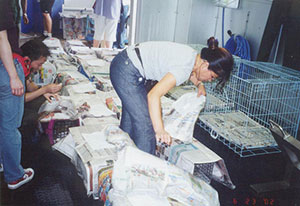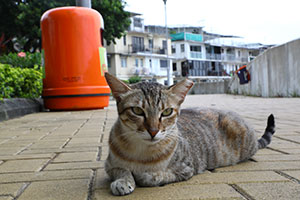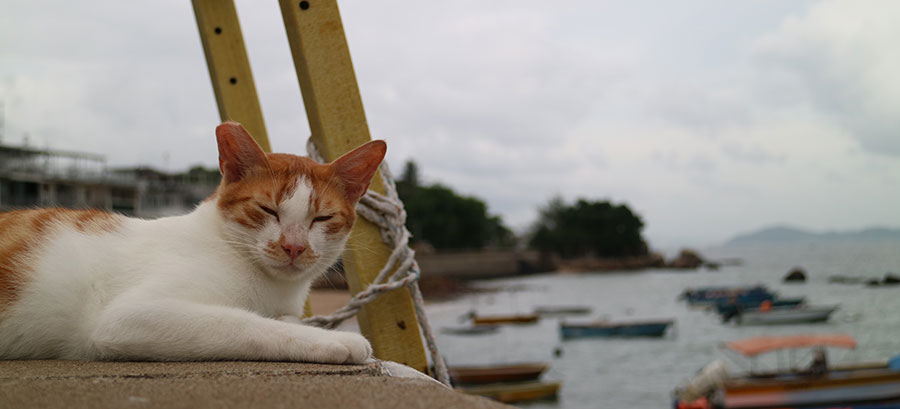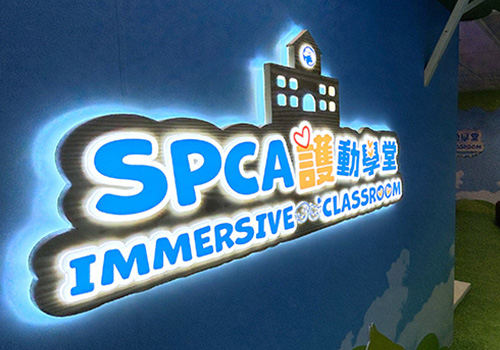
Did you know? Why are some street cats missing a corner of their ear?
This is what the SPCA utilises in its ‘Cat Colony Care Programme’ to identify stray cats that have been desexed through the Programme, so that we can monitor the Programme and avoid repeated unnecessary operations for already-sterilised cats. In order to distinguish the sex of the cat, male cats will have their right ear corner clipped, and female cats will have their left ear corner clipped.
Continue to bring hope and health to stray cats
In 1950s – 1960s unwell and unwanted cat were often discarded on the street or sent to the SPCA. In the early years cat owner’s poor behaviour coupled with uncontrolled reproduction on the street, and the public’s limited awareness of adoption, left the relevant government departments and the Society with no choice but to let the abandoned cats leave the world in a humane way. In an attempt to break this vicious cycle, the Society took the lead in introducing the concept of Trap-Neuter-Return (TNR) to control the number of street cats in the late 1990s and aimed to improve their welfare in a more humane and sustainable way. After much research and discussion, the Society officially launched the “Cat Colony Care Programme” (CCCP) in August 2000 to attack the problem at source.
Starting with a small group of enthusiastic volunteers, they identified cat colony one by one, gradually building up a record of street cat “pawprints” throughout Hong Kong. Volunteer carers put a great deal of time and effort to gradually gain the trust of cats in a colony. When the time is right, they will start a cat-trapping operation, sometimes with support from the Society’s welfare team or experienced volunteers. As the driving force behind the CCCP, the Society undertakes the overall management and liaison works to ensure that it operates smoothly and successfully. This is in addition to providing practical support in terms of desexing, vaccinations, microchipping and basic preventative treatment against parasites. Finally, the cat’s ear is “tipped”, enabling easy identification as being desexed and part of our Programme, and most importantly helping to safeguard their future. It is not a missing corner, but a mark of happiness and health!
CCCP Achievement
CCCP Ear-Tipped Cats: 18-District Pawprint Map
- Central & Western District: 133
- Eastern District: 93
- Island District: 119
- Southern District: 118
- Wan Chai District: 83
- North District: 102
- Tai Po District: 124
- Tuen Mun District: 106
- Yuen Long District: 237
- Tsuen Wan District: 78
- Kwai Tsing District: 72
- Shatin District: 129
- Kowloon City District: 112
- Kwun Tong District: 75
- Sai Kung District: 109
- Sham Shui Po District: 60
- Wong Tai Sin District: 30
- Yau Tsim Mong District: 130
Total: 1910
20 Things You Have to Know about “Cat Colony Care Programme”
01
Prior to the launch of CCCP, “Cat boxes” were set up around Hong Kong and Kowloon for people to “post” kittens and adult cats. It was not ideal, but better than cats being abandoned on the streets.

02
Anthony Leung, the Society’s Deputy Head of Inspectorate was assigned to collect abandoned cats from “cat collection boxes” back in the days. He remembers opening the boxes and saw a lot of the cats were new-born kittens also suffering from injuries or illness. In fact, 80% of the cats were injured and sick.
03
When the Programme first launched, it covered eight regions in Hong Kong with only 10 CCCP volunteer carers, one full-time veterinary nurse and the SPCA providing free desexing surgery.
04
In the early stage of the CCCP, the SPCA set up a Community Relations Inspectors team to help implement and promote the Programme in the community. It is now replaced by two full-time staff and a vast network of volunteers, but the SPCA Inspectorate team continues to help monitor the condition of the various cat colonies on Lamma Island.

05
The SPCA built the CCCP slowly but later to a level when there was a full-time vet and 2 nurses operating 5 days a week on up to 50+ cats per day. At our height, we were performing more than 6,000 surgeries per year.
06
Lamma Animal Welfare Centre was one of the first members of the SPCA CCCP team. From the days when every garbage bin on Lamma was feeding station for feral cats until today when you rarely see a cat around, we have witnessed a reduced number of strays.

07
Mrs. Lucy Wong, a Trustee of the SPCA and a horse owner recommended the CCCP to the Jockey Club Veterinary Department to assist with population and health management of the cats in the stables which were kept to help with rodent control.

08
In 2003, the Jockey Club loaned out the stable’s veterinary recovery facilities as temporary operating rooms, so that the Society’s veterinary team could perform sterilisation on the spot. This “Cat Nip Mission” (a large-scale cat trapping operation) desexed 79 cats.

09
Some horse trainers have been so impressed with the results that they regularly donated to the Programme. Over the past 17 years, some stables have opened their own “cat worlds”, and the feline friendly staff have become volunteer carers to help us manage their cat populations.
10
Lingnan University had been troubled by the presence of street cats from 2004. After many lobbying sessions and educational activities, the Lingnan Cat Colony was borne three years later. In 2007, the SPCA team arranged a “Cat Nip Mission” on the campus of Lingnan University. Utilising the mobile Animal Welfare Vehicle, manned with two veterinary surgeons, welfare nurses and volunteers, a total of 91 cats were desexed.

11
Setting up a Cat Colony in Sha Tau Kok was really difficult. Luckily, Wince, an original inhabitant who began feeding stray cats in her teenage year, took the initiative and set up a colony with the Society’s help. In 2010, she became a volunteer carer, and assisted the SPCA team in organising six large-scale sterilisation operations in Sha Tau Kok. To date, the Programme has benefitted more than 480 cats, and now there is close to a 90% desexing rate in Sha Tau Kok.

12
In 2000, a cat lover Miss Lam from Peng Chau who had been taking care of feral cats became one of our first volunteers. She helped to extend our Programme to Peng Chau and Hei Ling Chau and assisted in desexing countless cats. With the support of many local residents, she has also set up a dog shelter on the island to house stray dogs. The Programme has successfully reduced the number of street cats in Tung Wan, Peng Chau from more than 20 to 6 currently.

13
SPCA’s Chief Veterinary Surgeon Dr Jane Gray was a CCCP carer herself and looked after “Wong Mao” a male street cat lived near her apartment, and he lived to be 16 years old before it passed away due to cancer.

14
Dr Jane’s most favourite case in recent years was in 2018, when a street cat called “Bobby” was brought in by our inspectors with a severe neck injury. His wound was so large and infected he required three separate surgeries with special skin flaps to close. Through the dedication of his volunteer carer and a lot of hard work by the Society’s veterinary and welfare team, a month later he was able to be released back to the street.
15
For cats that were suitable for adoption, the Society would help them to find a loving home. Genki and Toro, two street cats that became part of the Cat Colony Care Programme has eventually found a forever home in 2019.

16
The first step in our “Trap-Neuter-Return” programme is to trap the cat. Feral street cats when trapped usually are very frightened, and generally try to escape which may lead to injury. To avoid this stress, the SPCA devised a trap cover made of fabric designed to keep the cats both safe and calm.
17
Soon after the CCCP was launched, the Society enlisted the help of an 86 years old volunteer Ms. Hong who was adept at sewing. She makes around 36 cat trap covers every year, which throughout the years, has probably amounted to around 700 covers. Unfortunately, she broke her wrist last year and is not able to sew anymore.

18
Hong Kong is not the first place in the world to operate a Trap-Neuter-Return (TNR) programme. Back in 1950s, the United Kingdom had already started using TNR to humanely control the stray animal population. Soon after, the United States, Denmark, Canada and other countries successively adopted similar measures
19
Ear-tipping, the universal sign of a sterilised feral cat, happens during the desexing surgery. In Hong Kong, a cat with a right ear tipped signifies a male cat while a female cat will have a left ear tipped. Around the world, different animal organisations will tip the ears in different manners.

20
If you see a street cat, please do not try to cuddle or catch it. Street cats are very wary of strangers and may feel uncomfortable and threatened if you get too close to them. Streets cats are a part of our community. We should respect them by not disturbing them.
The Future of CCCP

The SPCA hopes to include more areas in the Programme, including: country parks, LCSD parks, private areas and some restricted areas. We expect to expand facilities and increase capacity at our branch clinics, this together with the opening of our New Tsing Yi centre will provide carers with more convenient desexing locations closer to their colonies.
In the meantime, we will continue to lobby the government to formally include TNR methodology as part of its animal management strategy and to consider how feral or street cats entering into AFCD animal management centres may also be able to benefit from the Programme as well as, allocating resources to support the implementation of the Programme.
The Cat Colony Care Programme has transformed the lives of many street cats. We would love to have your help and donation.












